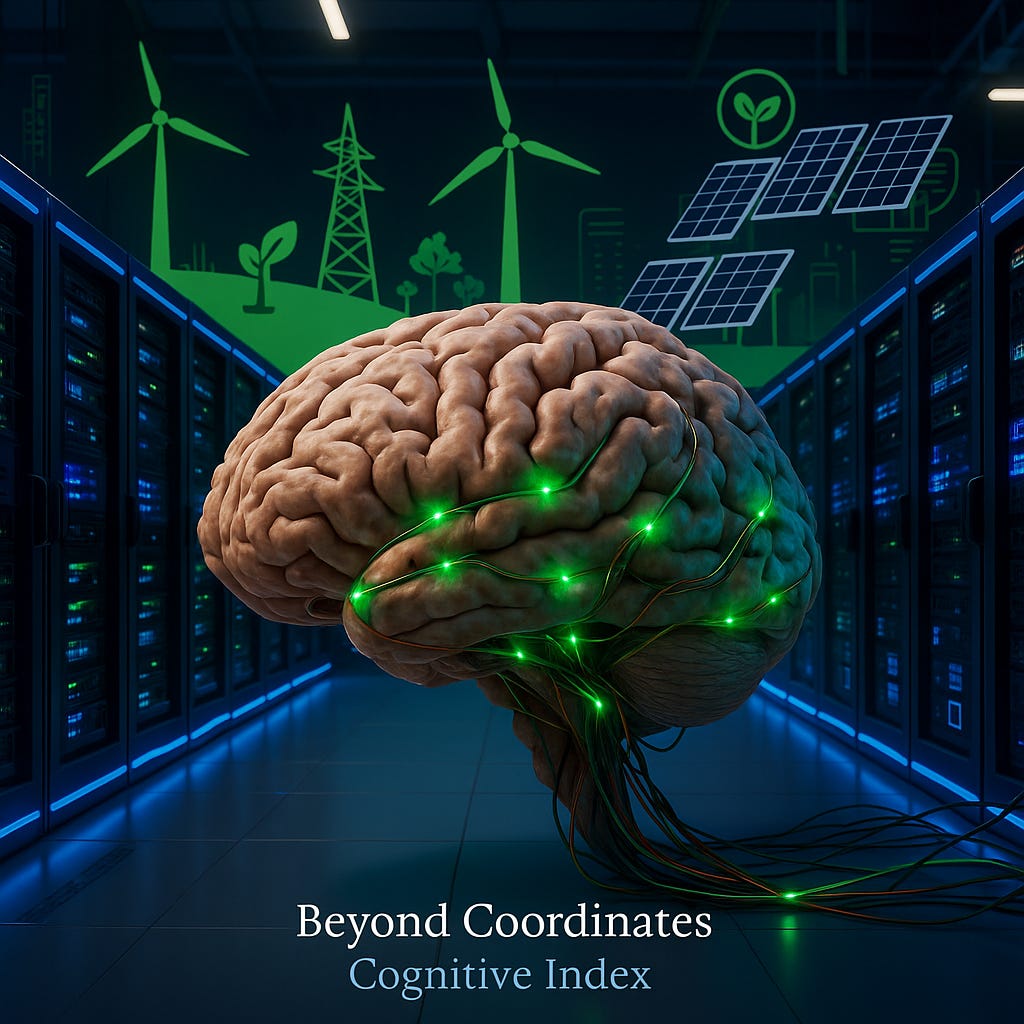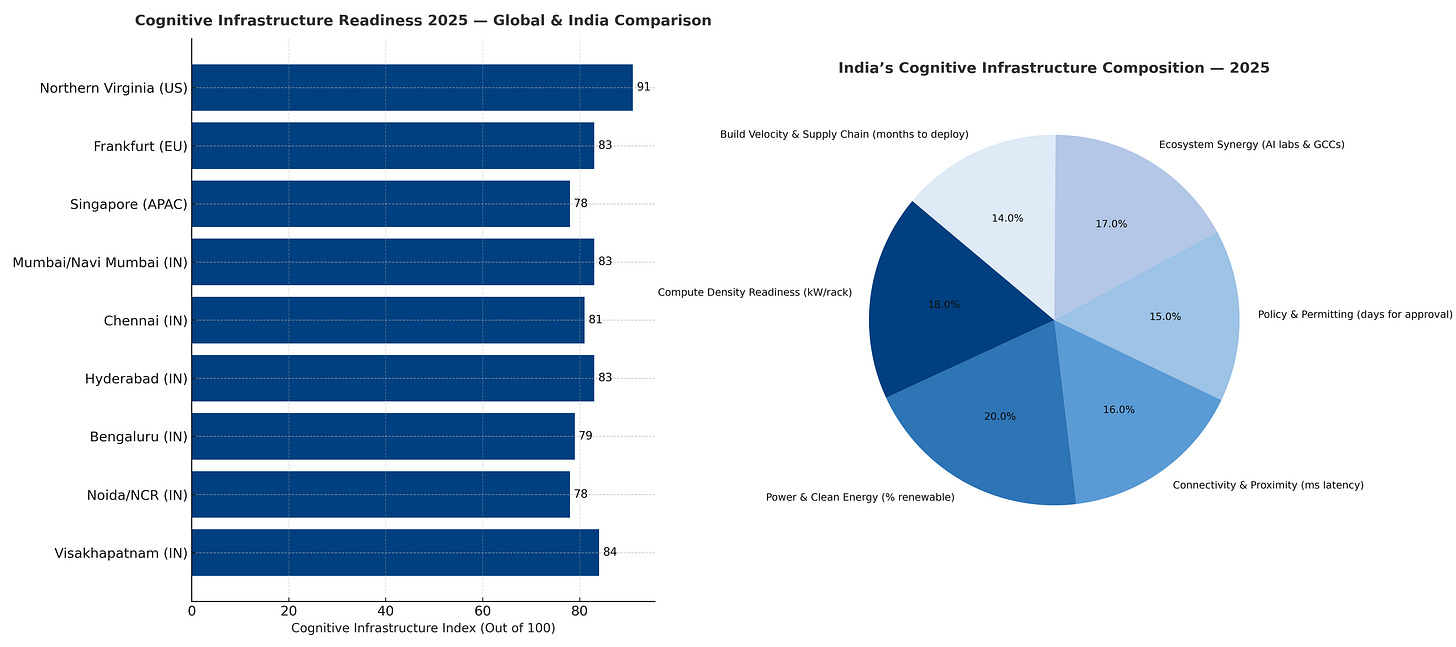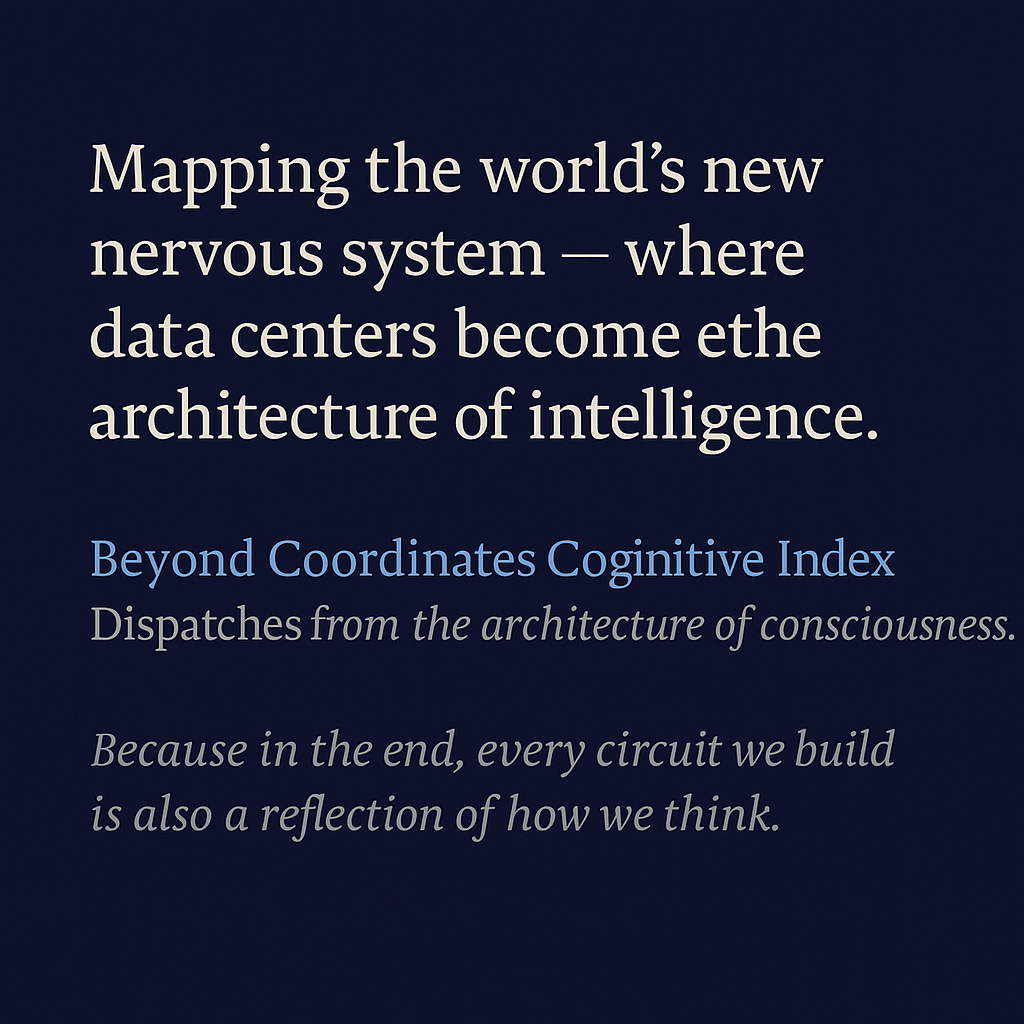🧠 Cognitive Index 01 — The Shifting Architecture of Intelligence.
Decoding the world’s data-center revolution — how the geography of energy, AI, and infrastructure is reshaping the architecture of thought.
Prologue | The New Nervous System
Every civilization leaves behind an architecture that once contained its mind. Ancient India built temples where geometry became theology; Alexandria built libraries that turned ink into memory; the industrial age built railways, exchanges, and power stations. Our era constructs data centers—steel monoliths on the edges of cities that hum with light, power, and language. They are not simply infrastructural facilities; they are the cognitive organs of the twenty-first century, housing both the memory and the metabolism of digital civilization.
When Google announced a one-gigawatt AI-enabled data-center campus in Visakhapatnam, its largest outside the United States, the event represented more than an investment milestone. It marked a symbolic realignment in the geography of cognition itself. The network of intelligence is shifting eastward—toward regions where talent, policy, and sustainability converge in ways that make new forms of computation possible.
I | The Cognitive Overload
Artificial intelligence has stretched the material boundaries of infrastructure. A single large-language model can now consume as much energy as a small city, transforming electricity into inference and heat into meaning. The limits of imagination are increasingly bound by the limits of the grid. Global hyperscale capacity is projected to surpass fifteen gigawatts in 2025, with AI workloads accounting for nearly half of that total. Cooling, once an operational afterthought, has become strategic. Cities such as Dublin, Singapore, and Amsterdam have paused new permits due to energy or water stress, while others—Johor, Chennai, and Phoenix—race to absorb overflow demand. The geography of compute is being reorganized around the physics of intelligence rather than the politics of borders.
II | The Geography of Thinking Machines
Each megawatt of computation creates a new coordinate in the world’s cognitive map. The traditional triangle of America, Europe, and East Asia is now joined by an emerging Indian constellation. Mumbai and Navi Mumbai function as the western nerve center, where finance meets subsea connectivity. Chennai anchors the eastern cable corridors into Southeast Asia. Hyderabad and Bengaluru operate as the innovation belt of Global Capability Centers and AI laboratories. Noida and the NCR manage governance and compliance. Visakhapatnam, through Google’s 1-GW campus, becomes the newest node in this network, turning India’s eastern coastline into a continental corridor of digital cognition.
To see this architecture in motion, watch the visual tour below:
A rare, behind-the-scenes look at Google’s infrastructure — power, cooling, security, and scale brought to life- Video Credit Google Workspace
The logic of this shift is geoeconomics as much as technological. Andhra Pradesh offered the trinity that AI infrastructure requires most: land, renewable power, and latency proximity. Google added scale, credibility, and global interconnection. Together they illustrate how computation is beginning to follow not merely capital but also climate, connectivity, and conscience.
III | The Twin Engines of Expansion
Beneath the rapid construction of new data-center corridors lies a quieter but equally transformative phenomenon: the rise of Global Capability Centers (GCCs) and AI R&D laboratories. India now hosts more than nineteen hundred GCCs, with nearly one-third engaged in advanced analytics, AI, or cybersecurity. As these entities evolve from back-office cost centers into innovation engines, they demand environments that are secure, compliant, and close to talent. Data centers gravitate toward them much as neurons form around synapses. Hyderabad and Bengaluru have become neural cities, where ideas, data, and electrons coexist in an intricate cognitive ecosystem.
IV | Obsolescence and Transition
The infrastructure of the previous computing age is reaching its physical and conceptual limits. Air-cooled, low-density data halls can no longer sustain the thermal load of GPU clusters. Manual operations are giving way to automated orchestration; centralized monoliths are fragmenting into modular, edge-connected networks. Yet the deeper obsolescence is institutional. Policy still imagines the “cloud” as ethereal and frictionless, when in truth intelligence has become material—rooted in copper, carbon, and water. The governance of cognition remains trapped in metaphors that the technology itself has already outgrown.
V | Policy, Power, and Planet
India’s governments increasingly recognize data centers as strategic infrastructure. Maharashtra, Tamil Nadu, Telangana, and Andhra Pradesh now provide incentives such as power rebates, fast-track clearances, and land support. The Digital Personal Data Protection Act, alongside sectoral norms from the Reserve Bank of India and SEBI, reinforces the localization of data and, by extension, the expansion of domestic compute capacity.
Yet every ambition faces the constraint of resources. A thirty-megawatt facility can consume more than one hundred million liters of water annually for cooling. Transformer and switchgear delays extend project timelines; grids strain under new loads. The sustainability imperative is therefore not ornamental—it is structural. The next generation of facilities is being designed around efficiency: closed-loop liquid cooling, immersion systems, renewable power purchase agreements, and hour-matched clean-energy sourcing. The vocabulary of progress is evolving from megawatts installed to megawatts decarbonized.
VI | The Hyperscale Cartographers
Every era of infrastructure has its mapmakers.
In the age of cognition, those cartographers are hyperscalers — the cloud giants who build, own, or lease the vast majority of the world’s compute capacity.
From AWS and Microsoft Azure to Google Cloud, Meta, and Oracle, their footprints now stretch across more than a hundred active regions and edge zones.
Each new hyperscale campus isn’t merely a data hall; it’s a geopolitical marker — a declaration of where the next decade of digital gravity will rest.
Their investments increasingly follow energy availability, latency corridors, and sustainability alignment rather than just market demand.
In India alone, hyperscalers have pledged over $12 billion in capacity expansion by 2027, with Mumbai, Chennai, and Hyderabad emerging as critical availability zones.
The pattern is unmistakable: as intelligence globalizes, so does its physical scaffolding — mapped by companies whose networks now rival nations.
VII | The Cognitive Index
Mapping the world’s new nervous system — where data centers become the architecture of intelligence
The Cognitive Index is a structured framework designed to assess how responsibly a nation constructs its architecture of intelligence. It evaluates six interdependent dimensions:
Compute Density Readiness – The ability to host high-density, AI-class workloads.
Power and Clean Energy – The reliability and sustainability of the electricity ecosystem.
Connectivity and Proximity – The richness of fiber, subsea cables, and latency performance.
Policy and Permitting – The clarity and responsiveness of the regulatory framework.
Ecosystem Synergy – The density of GCCs, R&D centers, and academic partnerships.
Build Velocity and Supply Chain – The capacity to translate intent into operational infrastructure.
Methodology — How the Cognitive Index Works
The Cognitive Index is a way to measure how responsibly and intelligently a country or city is building its digital infrastructure — especially data centers, AI facilities, and connected ecosystems.
Instead of only looking at how many data centers exist or how big they are, the index focuses on how balanced and future-ready the entire ecosystem is — across technology, sustainability, policy, and human innovation.
It looks at six major areas, called pillars, that together describe how mature a region’s “intelligence infrastructure” really is:
Compute Density Readiness – How capable the region is of handling advanced AI workloads and high-performance computing.
Power & Clean Energy – Whether the energy powering these facilities is stable, reliable, and increasingly renewable.
Connectivity & Proximity – How strong its fiber, subsea cables, and network speed are to reduce latency and connect with the world.
Policy & Permitting – How clear, fast, and supportive the government’s data-center and digital policies are.
Ecosystem Synergy – The presence of technology talent, AI labs, Global Capability Centers, universities, and partnerships that create innovation momentum.
Build Velocity & Supply Chain – How quickly ideas turn into operational infrastructure — including land readiness, logistics, and materials.
Each of these pillars is rated on a simple 1 to 10 scale, based on available public data and industry research.
A score of 10 means global best practice.
A score of 1 means the region still faces major gaps.
Because some factors matter more than others, each pillar has a weight (importance level).
Compute and Power count a little more (20% each), because without energy and hardware, nothing runs.
The rest — Connectivity, Policy, Ecosystem, and Build Velocity — each contribute 15%.
All these weighted scores are then added up to create a final Cognitive Index score out of 100.
The higher the score, the more balanced and sustainable that region’s infrastructure is — not just powerful, but conscious.
How to Read the Score
80–100: Cognitively Mature — globally competitive and sustainable.
60–79: Evolving — growing fast, but needs improvements in reliability or policy.
40–59: Emerging — early-stage, strong intent but low integration.
Below 40: Nascent — limited infrastructure or ecosystem development.
Data Sources
The scores are based on publicly available information from:
Scores are indicative; they express relative maturity rather than official rankings.
CBRE, JLL, IDC, and Structure Research industry reports
State and national government data-center and IT policy documents
Energy and renewable data from IEA and CEA India
Disclosures from data-center operators like NTT, CtrlS, AdaniConneX, Yotta, and Google
Internal synthesis by Beyond Coordinates Cognitive Index Research (2025)
VIII | The Cognitive Ledger
If GDP measures production and ESG measures conscience, the Cognitive Index measures awareness—the ability of a society to expand intelligence without exhausting the planet. In 2025, India’s cognitive-infrastructure ecosystem scores 83 out of 100, a profile described as Cognitively Mature, Sustainably Conscious. Its strength lies in policy clarity, renewable integration, and ecosystem depth; its vulnerabilities are rooted in power stability and water use. The country once known for exporting code now exports capacity to think, architected through energy, geography, and governance.
Epilogue | Memory, Heat, and Conscience
To stand beside a data center at night is to sense the vibration of collective memory—the quiet resonance of a civilization thinking. Each watt is a syllable in an endless planetary sentence. From the western corridors of Navi Mumbai to the rising towers of Visakhapatnam, India is learning to host not only data but also destiny. The challenge before us is moral rather than mechanical: to ensure that the pursuit of intelligence does not eclipse the presence of conscience.
Progress will not be measured by how much we compute, but by how gracefully we remember.
Signature Analysis — Beyond Coordinates (2025)
Cognitive Score: 83 / 100
Verdict: Cognitively Mature, Sustainably Conscious
Observation: The direction of intelligence is turning east.
Mapping the world’s new nervous system — where data centers become the architecture of intelligence.
Because in the end, every circuit we build is also a reflection of how we think.
© Beyond Coordinates | Cognitive Index Series 2025
Dispatches from the architecture of consciousness.
An expanded long-form edition of this essay is also available on Medium, featuring a global editorial layout and updated reflections.





